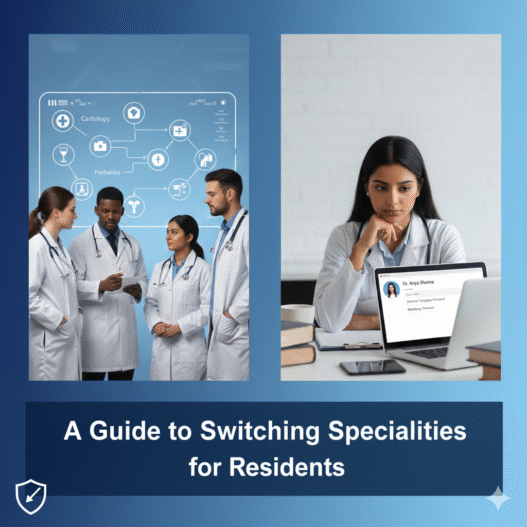In the 2022–2023 academic year, 1,153 residents (roughly 0.7% of active trainees) changed their specialty.
The American Medical Association reports about 1,000 residency transfers annually. This raw data provides a mere glimpse at an underlying problem we have yet to contend with. Apart from those physicians who actually go through with it, many others quietly consider a course correction.
The idea of switching specialties is not some fringe phenomenon. It's happening everywhere, especially in emergency medicine, where burnout is an epidemic; in primary care, where the pay-to-stress ratio has flatlined; and even in highly competitive fields like surgery, where long call hours grind down morale.
When you factor in the $200,00+ of average medical school debt, it becomes obvious why the decision isn't made lightly.
Switching specialties used to be seen as rare, almost taboo. Now, it's becoming an increasingly realistic career pivot.
But how do you actually pull it off? What does it cost? And how much of your training counts when you jump ship?
The decision to switch medical specialties is not one to be taken lightly. It's a process that can evoke uncertainty, self-doubt, and numerous logistical challenges. Whether you are in the middle of residency or years into your career, the thought of starting over or making a significant shift can be intimidating.
If you've ever felt like your specialty just doesn't align with your values or lifestyle anymore, you're not alone. It's a tough decision, but many physicians have been there and made the switch.
The structural frictions of training mean switching is logistical, emotional, and expensive. Here's how to do it with the least career damage.
Wondering How you should Choose a Medical Specialty? Click to learn more.
Why Physicians Switch Specialties
While burnout may be cited as the headline reason, there are other drivers at work as well.
The most common reason physicians switch specialties is a mismatch between day-to-day reality and early expectations. Medical school rotations are brief snapshots. A month in inpatient pediatrics or two weeks of psychiatry rarely capture the full scope, the bureaucracy, or the emotional weather of a full career.
Michael G. Rydberg, MD, shared his experience in the Journal of Graduate Medical Education (JGME). For him, leaving urology for internal medicine felt like “asking for a divorce from people who invested in me and cared for me.” Yet he thrived in his new field (internal medicine) and eventually became chief resident.
Stress is another reason. Specialties such as emergency medicine, anesthesia, and critical care involve chronic exposure to high-acuity, life-or-death decision-making. Some of us thrive under that constant pressure. While others discover they need more deliberation and longitudinal relationships with patients.
Conversely, fields like psychiatry demand patience and tolerance for ambiguity, which can be draining for those who crave concrete procedures and immediate results.
Money, too, plays a role. According to Medscape, the pay gap between pediatrics or family medicine and procedural specialties (orthopedics, cardiology, dermatology) exceeds $250,000 annually.
Source: Medscape
Residents who originally chose a “calling” may later feel the weight of debt, inflation, delayed gratification, or familial responsibilities and reconsider.
With burnout being an ever-present shadow, some doctors leave surgical fields with punishing schedules for specialties that allow more predictability and family time.
Work-life balance is one of the most cited reasons for a specialty change, both during and after residency.
Some fields, like dermatology or psychiatry, offer more predictable hours and fewer on-call shifts, while others, especially in surgery, can come with longer hours and higher stress. If you're looking for a more manageable schedule, switching to a specialty that allows for greater personal time is a valid reason to make the change.
Finally, sometimes, it's the simple fact of the matter that after years of practicing a particular specialty, a physician can realize that their true calling lies elsewhere in medicine.
Whether it's a desire to transition into a more research-focused role, a shift into public health, or exploring an entirely different clinical field, the pull toward a new passion can be compelling enough to warrant a career change.
Click here to find out what the Highest Paid Specialties For Doctors are.
Is It Possible To Switch Specialties During Residency?
Yes. In fact, residency is the most common time physicians switch specialties because you're still “in training mode” and more flexible with GME funding. But keep in mind that it's neither easy nor quick.
Most residents who switch do so in their first or second postgraduate years. That timing matters because residency slots at the PGY-2 and PGY-3 levels are limited, and programs prefer candidates who have not advanced so far that they need to unlearn ingrained habits.
The process almost always occurs outside the Match. Instead of going through the NRMP again, residents cold-call or email program directors, apply through ERAS off-cycle, and rely on networks.
Once you've decided that switching specialties is the right move, the next step is to gather as much information as possible.
Begin by researching the new specialty. Take the time to learn more about it. Spend time shadowing physicians in that field, attend relevant seminars, and read up on the specific training requirements.
This is where your desire to switch will be tested, and you'll want to make sure the grass is truly greener on the other side.
Next, consult with your current program director. You'll need to have an open conversation with your current program director about your decision. If they're supportive, they may help facilitate the transition or at least guide you on how to approach the switch. In this instance, faculty letters of recommendation are a key component of a successful switch. Building rapport with empathetic mentors who believe in your potential in another specialty can make the difference between a closed door and a transfer.
Then, you need to identify open positions. Residency programs are competitive, and securing an open slot in a different specialty often requires direct outreach. Use resources like the AMA's FREIDA database or AAMC's Residency Explorer Tool to check for available positions in other programs.
Be proactive — contact program directors directly to inquire about potential openings. You might also find vacant positions posted on hospital websites.
Finally, you'll need to put together a new application packet, including your updated CV, personal statement, and letters of recommendation. Make sure to explain why you're making the switch and highlight the skills and experiences from your current specialty that will make you a valuable addition to the new program.
Logistics are messy. Some residents leave one program before securing a new slot.
Others moonlight if they have a state license and have passed Step 3, or take research positions to bridge the gap. It is not uncommon to need peers to cover shifts while you interview, which means you owe goodwill back in spades. And it is essential not to burn bridges.
As one UAG faculty resource stresses, leaving in good standing and timing your departure at the end of an academic year are vital if you want strong letters and a smooth transition.
How to Switch Specialties After Residency
Switching specialties after completing residency (as an attending) is possible, but the road is far longer and more expensive.
Most physicians need to go through a fellowship or a second residency.
An internist might do a preventive medicine fellowship. A family doc could shift into sports medicine. These aren't always full career changes, but they offer fresh paths.
The American Board of Medical Specialties (ABMS) governs certification of physicians in 38 specialties and 89 subspecialties, and board eligibility requires completion of accredited training. You can find the full list here.
Every state medical board has its own rules about recognizing prior training. Some may accept your first residency years toward a license, yet others may not.
For example, an anesthesiologist who wants to move into psychiatry cannot simply sit for the boards; they must complete an ACGME-accredited psychiatry residency, often from PGY-2 onward if prior training counts.
Likewise, a family physician moving into dermatology will likely need the full residency. That means three to four additional years at reduced salary, often less than half of what an attending makes.
A handful of exceptions exist. Some subspecialties allow crossover training. For instance, internal medicine physicians can transition into fields like allergy and immunology without restarting from scratch. Pathology residents can sometimes cross into laboratory medicine fellowships that broaden career scope.
Still, a complete course-correction like surgery to neurology or pediatrics to radiology will almost always require formal retraining. This means repeating 3–7 years of training, often with a significant pay cut (average resident salary is $65,557).
The emotional toll isn't negligible either. You go from attending-level autonomy and income back to trainee status, often in your thirties or forties.
You re-enter the call schedule, your peers may be a decade younger, and your family may need to absorb the financial hit. To soften that financial blow, many doctors moonlight in urgent care, telemedicine, or hospitalist roles while transitioning.
If you're less interested in clinical work and more in healthcare administration or research, consider pursuing certifications, an MBA, or a fellowship.
Roles like physician executive positions, health policy experts, or clinical research directors can utilize your medical expertise without requiring a complete specialty switch.
Is It Possible To Switch Specialties Without Doing Another Residency?
Switching specialties without completing another residency is, in almost all cases, not possible if your goal is board certification in the new field.
The Accreditation Council for Graduate Medical Education (ACGME) requires physicians to finish the accredited training program specific to their specialty, and while prior rotations may sometimes shorten the process, a true bypass is rare.
In some rare cases, physicians with significant overlapping training may pursue alternative pathways to board eligibility. For instance, an internist who has completed substantial pediatric rotations might pursue combined medicine-pediatrics training with credit.
Locum tenens and fellowships are often talked about as shortcuts, but they're not the loopholes they appear to be. Locum work only allows you to practice within the scope of your existing board certification, and fellowships typically require residency in a feeder specialty rather than serving as an alternate pathway.
At best, they expand the scope of what you can do within your original field, but they don't replace the formal requirement of a new residency if you want to change specialties outright.
The only real exceptions involve pivoting into nonclinical careers, such as research, industry, or healthcare technology, where residency training isn't strictly required. For clinical specialties, however, a second residency is the rule rather than the exception.
What are the best Non-Clinical Job Alternatives For Physicians? Learn more.
How Long Does It Take to Switch Medical Specialties?
The timeline depends on whether the switch happens during or after residency.
During residency, most transitions take six to twelve months from the first conversation with a program director to starting in a new specialty. It's best not to change specialties mid-year, since doing so can upend schedules and add strain to colleagues.
Aim instead to transition at the end of the academic term, when programs expect turnover. Exiting on good terms preserves relationships and keeps doors open down the road.
After residency, the process is measured in years. Completing another three- or four-year residency is standard.
The process of switching specialties involves three key steps: reflection, preparation, and action.
Reflection involves clarifying why you want the change and whether another specialty truly fits better.
Preparation requires networking, gathering documents, and financial planning.
Action is the application and interview phase, which often feels unpredictable.
It's important to map out these steps realistically to save heartache.
What's the Average Cost of Switching Medical Specialties?
The cost of switching specialties is nothing to sneeze at.
First, there is the opportunity cost. An attending earning $440,000 annually in anesthesiology, will upon re-entering residency at $65,000 a year, lose over $1 million in income over three years.
Factoring in relocation costs, licensing fees, ERAS fees, and potential loan forbearance interest, means that the financial burden would be staggering.
Residents switching early absorb less loss, but still face disruption. Interview travel, relocation, and months without a stable paycheck can add up.
Few insurers or lenders offer products tailored for mid-career specialty changers. That's why planning ahead, with savings or spousal income as a buffer, is critical.
In short, the average cost of switching specialties post-residency can easily rack up to $1M, considering lost income. During residency, the cost is lower, but still significant.
Which Specialties Are Easiest to Switch Into?
Broadly speaking, fields with chronic shortages and high turnover are the most accessible.
Internal medicine, family medicine, and pediatrics are more open to midstream transfers than competitive specialties like dermatology, orthopedic surgery, or plastic surgery.
According to National Resident Matching Program (NRMP) data, unfilled positions in family medicine and internal medicine are more common, creating occasional openings for transfers.
That said, “easy” is relative. Even these fields require strong applications, program director support, and timing.
The ease of switching also depends on whether there are transferable skills and credits between your current specialty and the one you're aiming for. Switching into hyper-competitive specialties almost always requires reapplying from scratch through the Match.
Additionally, preventive medicine and occupational medicine often attract physicians looking to pivot without redoing a full residency.
Yasmine S. Ali, MD, a cardiologist at Vanderbilt University in Tennessee, reached a crossroads in her decade-long career and decided to pivot toward her longtime interest in preventive medicine. She now runs her own practice focused on prevention and also mentors physicians exploring nontraditional career paths.
“In my cardiology practice, I felt like I was doing a lot of damage control, so I decided to pursue my interest in preventive medicine by starting my own practice and writing about health and wellness,” she explained.
Can International Medical Graduates Switch Specialties in the U.S.?
Yes, international medical graduates can switch specialties in the U.S. but with additional hurdles. International medical graduates (IMGs) already face steep odds in securing residency slots.
According to the 2024 NRMP data, the Active Applicant Placement Rate for U.S. MD seniors was 97.8 percent, with a PGY-1 match rate of 93.5 percent. U.S. DO seniors fared similarly well, with a 98.4 percent placement rate and a 92.6 percent PGY-1 match rate.
By contrast, U.S. IMGs had a placement rate of 73.5 percent and a 67.8 percent PGY-1 match rate, while non-U.S. IMGs trailed further with a 60.3 percent placement rate and only 58 percent matching into PGY-1.
TLDR: nearly one-third of U.S. IMGs and more than 40 percent of non-U.S. IMGs went unmatched in 2024.
Switching specialties midstream means competing for an even smaller pool of open positions, which compounds these already stark disparities.
For IMGs, the uphill battle is real, even when they bring valuable clinical experience to the table.
“Many IMGs tend to work in rural and medically underserved areas, often to fulfill visa obligations, and this finding indicates that IMGs not only ensure access to care for such populations, but may be more effective because of their unique position,” says Dr. George Abraham, MD.MPH, president emeritus of the American College of Physicians.
IMGs must ensure visa stability, as a switch could jeopardize J-1 or H-1B status. They also need to secure a new ECFMG verification if applying to a new specialty.
It's by no means impossible for an IMG to switch specialties, but it does require careful planning.
Breaking Down Popular Specialty Switches
Switching specialties is not a one-size-fits-all process. Some transitions are more common than others, often reflecting lifestyle trade-offs, burnout patterns, or compensation differences.
Below are four of the most frequently discussed specialty pivots, with notes on feasibility, training credit, and long-term payoff.
Internal Medicine to Dermatology
One of the toughest transitions in medicine, this switch highlights the gap between foundational training and highly competitive subspecialization.
Internal medicine offers deep grounding in systemic disease, but dermatology remains one of the most exclusive residencies. In 2023, only 499 slots were available nationwide, and the match rate for U.S. MD seniors was about 60%.
Physicians attempting this change should expect limited credit for prior years and, in most cases, a restart of residency training.
Still, the financial upside is significant as dermatologists report a median annual compensation of $454,000 versus $294,000 for general internists. Plus, the lifestyle shift that comes with fewer inpatient demands and more outpatient focus, is often a motivating factor.
Surgery to Radiology
This pivot is an indicator of a growing awareness of lifestyle imbalance in surgery.
General surgery carries one of the highest burnout rates at 40%, compared to radiology at 33%. Radiology offers more predictable hours and lower overnight burden, while surgical skills in anatomy and procedural techniques can translate especially well in interventional radiology.
Some programs grant partial credit, but many require near-complete retraining. Financially, the difference is there, but not too extreme. Surgeons average $434,000, while radiologists earn $526,000. For many, the real draw is not salary but sustainability.
Emergency Medicine to Psychiatry
This is perhaps the most visible specialty migration in recent years and is often a result of burnout.
Emergency medicine consistently ranks highest in physician burnout, with more than 63% reporting symptoms in Medscape's 2024 survey. Psychiatry, meanwhile, faces a critical workforce shortage and reports one of the lowest burnout rates at 39%.
Source: Medscape
Transferability is strong as EM doctors bring extensive experience with acute psychiatric presentations, substance use, and trauma.
Compensation is lower, yes, with $388,000 in EM versus $341,000 in psychiatry, but many find the trade worthwhile for the steadier pace, fewer nights, and the chance to build ongoing patient relationships.
Pediatrics to Anesthesiology
For pediatricians, one of the lowest-earning specialties ($265,000), anesthesiology's compensation levels ($501,000) can be a major draw.
Beyond pay, the appeal lies in procedural intensity and the option to subspecialize in pediatric anesthesiology, where prior pediatric experience is a distinct advantage.
The transition is challenging since most physicians must repeat substantial portions of training, with minimal credit from pediatrics.
Still, the long-term professional and financial benefits are often considered worth the reset, especially for those seeking greater procedural variety and hospital-based practice.
Six-Month Roadmap to Switching Medical Specialties
You can't improvise switching specialties; it requires deliberate pacing. This six-month roadmap can help structure the process so that each step feels intentional rather than reactive.
| Month | Focus | What to Do |
| 1 | Reflection | Write down, clearly and honestly, what you dislike about your current specialty and what you hope another will offer. Use this as your compass for the switch. Really ruminate on your reason/s to make sure they're valid. |
| 2 | Conversations | Talk with mentors, program directors, and trusted peers. And begin discreetly assembling your application materials. |
| 3 | Outreach | Contact program directors in your desired specialty to ask about open positions. Update your CV and personal statement as well. |
| 4 | Exploration | Gauge whether real transfer opportunities exist. If so, start preparing for interviews while maintaining your current duties. |
| 5 | Decision | Weigh offers quickly, balancing location, training quality, and financial feasibility. This is the high-stakes month. |
| 6 | Transition | Exit your current program in good standing, thank colleagues who supported you, and gear up for your new specialty. |
Key Requirements for a Specialty Switch
The paperwork burden is heavier than most expect, and the financial strain can be equally unforgiving.
Beyond transcripts, board scores, and recommendation letters, the letter of good standing often determines whether another program will take a chance on you.
At the same time, rent, loans, and lost income don't wait for your transition to smooth itself out.
Here's how the administrative and financial realities line up:
| Category | What You'll Need | Why It's Important |
| Documents | Updated CV (highlighting any transferable skills) | Shows continuity and relevance of your training. |
| Personal statement explaining your switch | Clarifies motivation without disparaging your current field. | |
| Letters of recommendation (at least one from current program director) | Confirms credibility and support from leadership. | |
| Medical school transcripts | Provides academic history and performance record. | |
| USMLE/COMLEX scores | Standardized measure of clinical knowledge. | |
| State medical license documents (if post-residency) | Required for practice and moonlighting opportunities. | |
| Proof of board certification (if applicable) | Demonstrates qualification and standing in your prior specialty. | |
| Formal letter of good standing from current program | Signals reliability; lack of this raises red flags. | |
| Financial Planning | Savings or spousal/family support | Bridges income gaps during transition. |
| Budget for rent, loan payments, and living costs | Prevents shortfalls when income is unstable. | |
| Loan deferral or forbearance strategy | Provides temporary relief but adds long-term cost. | |
| Moonlighting income (if licensed) | Helps offset reduced or lost salary. | |
| Realistic projection of lost earnings | Critical for attendings facing a multi-year income gap. |
What We Can Learn From Doctors Who Switched Specialties
You'd think that once you finish residency, your path is set. But the truth is, a surprising number of physicians hit the brakes, look around, and say: “This isn't it.”
Online forums are littered with stories of radiologists who walk away from high-paying scans to start over in urology, surgeons who burn out and switch tracks before year two, and pediatricians who pivot to dermatology for better hours and better pay.
One general surgeon even joked that switching meant “no more fingers up butts at work.” It's funny only because it's true.
What's striking isn't just the frequency of these career pivots, but the brutal honesty behind them. People aren't switching for prestige or flash.
They're doing it to save their sanity. Toxic work environments, soul-sucking shifts, and chronic sleep deprivation aren't character-building trials; they're red flags. And those who act on them early, even if it means starting over, often report relief that is rare in medicine.
The stories are varied but unmistakable in their message: when something isn't working, it's better to walk away than to grind through. A radiologist burned out in her 30s, only to find a second career in pain management.
A surgeon, sick of the relentless hours and emotional toll, left the OR for psychiatry. Each had their reasons, but they all dared to choose a new path, often bringing them far more peace than they had expected.
Switching specialties isn't for the faint of heart. Many wrestle with the enormity of repeating residency or the Herculean effort of gathering new letters of recommendation while still clocking in full-time. Some tap into old medical school networks.
Others hustle into electives, research years, or fellowships to build credibility from scratch. But almost all agree that it's better than being stuck in the wrong job for the rest of their careers.
And maybe that's the real lesson here. In medicine, we call it the sunk-cost fallacy. But outside of spreadsheets, it has a different name: burnout. You can't outwork regret, but you can outgrow it. Those who make the leap teach us that career regret doesn't have to mean a life sentence. It's actually a signal to reroute.
Have you ever switched specialties? We'd love to hear from you, and who knows, maybe your experience could be exactly the inspiration someone else needs to take the leap.
Frequently Asked Questions
How long does it take to switch medical specialties?
Usually 1–3 years during residency, or 3–7 years if you've already finished and must repeat training.
Can you switch specialties without doing another residency?
Rarely. Most require a new residency, though some prior training may shorten it. Alternatives include preventive or occupational medicine, fellowships, or nonclinical paths.
Can you switch specialties during residency?
Yes. This is the most common stage to switch. You'll need an open position and support from your program director. About 1,000 residents transfer yearly.
What's the average cost of switching medical specialties?
Anywhere from $100,000 during residency to $500,000–$1 million in lost income after residency.
Which specialties are easiest to switch into?
Fields with shortages like family medicine, internal medicine, pediatrics, and preventive medicine. Competitive specialties usually require reapplying from scratch.
Can international medical graduates (IMGs) switch specialties in the U.S.?
Yes, but it's harder. Match rates are lower (73.5% for U.S. IMGs, 60.3% for non-U.S. IMGs), and midstream transfers face fewer openings.
What alternatives exist if I don't want to repeat residency?
Options include preventive or occupational medicine, fellowships, consulting, public health, medical writing, or health tech.












